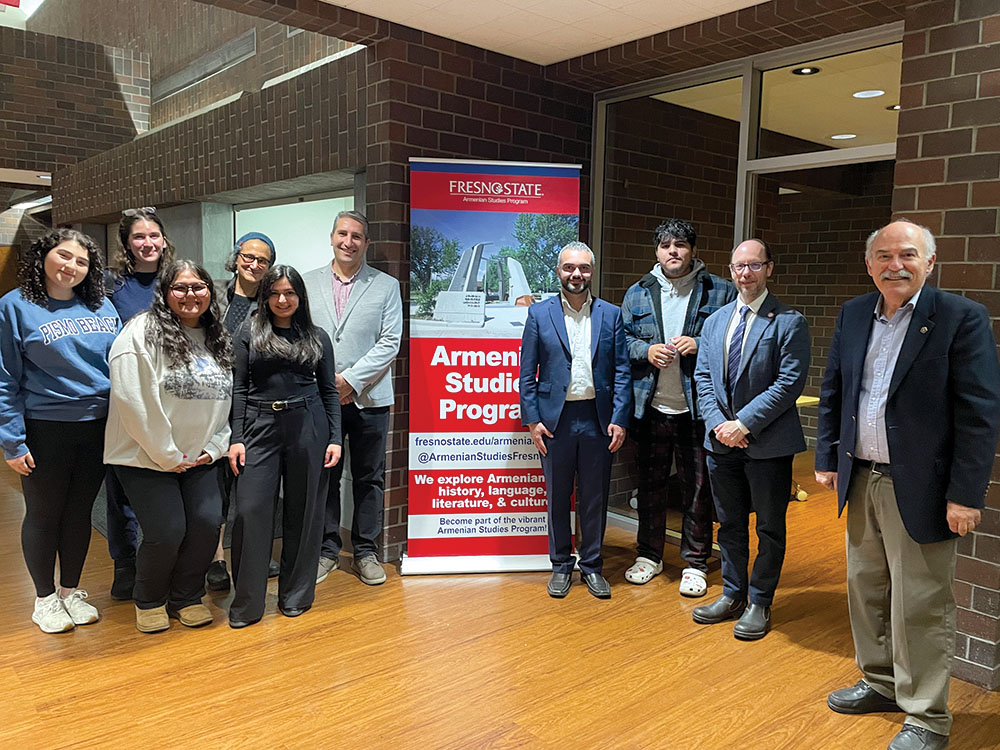
Ani Sargsyan
Staff Writer
“What happens to heritage in conflict? And how can we find pathways for saving what still survive?,” stated Dr. Simon Maghakyan, who presented a talk on “The Future of the Past: Pathways for Saving Armenian Vestiges in Turkey,” on Friday, November 8, 2024.
This was the final presentation in a three-part series by Dr. Maghakyan on Armenian Cultural Heritage in Turkey – past, present, and future. Dr. Maghakyan is the Kazan Visiting Professor in Armenian Studies for Fall 2024 and his presentation was supported through the Ralph Shabazian Armenian Memorial Fund.
Dr. Maghakyan began his lecture by referencing the first image in his presentation, a miniature model of the church of Aghtamar. He pointed out how some Kurdish vendors, because of their interaction with Armenians, had correctly learned to spell Aghtamar on souvenirs.
“It is a subtle and minor difference to outsiders, but for Armenians who have seen their history denied, dismissed and erased in Turkey, it is a big deal,” said Dr. Maghakyan.
Dr. Maghakyan explained that there are three general policies that he identifies in conflicts in regard to the heritage of the minority group.
Negation is the first type of conflict policy, which is the erasure of minority communities. This can take different forms, whether state-organized, state-sanctioned, or even exclusionary narratives and denialist discourse. Examples of negation include the 7th century St. John the Baptist church in Bagavan, which is now entirely gone. Dr. Maghakyan brought into light the state-sanctioned industrial looting of Armenian sites that is going on in Turkey right now. A very disturbing case was the example of a man in Istanbul, who has sold several million metal detectors to be used for looting Armenian churches and properties. He also provides YouTube videos explaining in detail how and where to use the detectors. Another example of negation is when Turkish authorities and organizations deliberately exclude the word Armenian to describe Armenian sites, in order to erase the Armenian connection.
The next policy in ethno-territorial conflict heritage management is neglect. Neglect comes in different forms: malign, passive, and active. However, neglect can sometimes allow for future preservation, since it buys time for the physical survival of some monuments.
The final and preferred form is negotiation, which can also take several forms – appropriation, toleration, and return. Dr. Maghakyan gave an example of appropriation with an image of a khatchkar that was now being used as a water fountain. He said that Armenians are the most important stakeholders of their heritage, especially in Turkey, but while having high interest, they have low impact. Dr. Maghakyan talked about ways to change this so that the impact can increase as well.
“Who owns the past?,” asked Dr. Maghakyan as he explored this question and expanded on it by stating what our responsibility is, and complex ways in which well-meaning people contribute to destruction. Examples of this are the looted coins collected from cemeteries and churches. While many Armenians would rather buy them so they fall in the “right hands,” Dr. Maghakyan challenged this perspective because of the way that Turkish and Kurdish individuals, often permitted by the state, are destructively finding them. Another disturbing example that Dr. Maghakyan mentioned was about an Armenian church that was for sale in the Urfa region in Turkey.
Dr. Maghakyan concluded the lecture by asking, “What happens next?” He stated that there are a few opportunities for change, including normalization – for example, opening the borders between Armenia and Azerbaijan. He singled out the antiquities trade memorandum of understanding between Turkey and the United States, which will be renegotiated in 2026, as a pathway for requesting specific preservation efforts. However, more challenges exist than opportunities. When the latter are overcome, it is often by the resilience of Armenian stakeholders.
Dr. Maghakyan referenced a fascinating example of community activism in Diyarbakir, which was able to convince not only the Armenian patriarchate in Istanbul, but also the Turkish Ministry of Culture and local administrators to come together and give seed money for the restoration of the St. Sarkis church, building upon the success of restoring – twice – St. Giragos. This small story is one of hope, primarily addressed to the diaspora with a message of responsibility to continue and expand this effort.
Dr. Maghakyan ended with a question for the audience to reflect on… “What is it that can be done, and must be done to save the future of the past of Western Armenians?”
 Hye Sharzhoom Armenian Action
Hye Sharzhoom Armenian Action